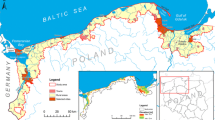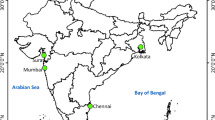Abstract
The paper provides a first quantitative estimate of the potential number of people and value of assets exposed to coastal flooding in Dar es Salaam, Tanzania. The study used an elevation-based geographic information system-analysis based on physical exposure and socio-economic vulnerability under a range of climate and socio-economic scenarios. It particularly considered a worst-case scenario assuming even if defences (natural and/or man-made) exist, they are subjected to failure under a 100-year flood event. About 8% of Dar es Salaam lies within the low-elevation coastal zone (below the 10 m contour lines). Over 210,000 people could be exposed to a 100-year coastal flood event by 2070, up from 30,000 people in 2005. The asset that could be damaged due to such event is also estimated to rise from US$35 million (2005) to US$10 billion (2070). Results show that socio-economic changes in terms of rapid population growth, urbanisation, economic growth, and their spatial distribution play a significant role over climate change in the overall increase in exposure. However, the study illustrates that steering development away from low-lying areas that are not (or less) threatened by sea-level rise and extreme climates could be an effective strategic response to reduce the future growth in exposure. Enforcement of such policy where informal settlements dominate urbanisation (as in many developing countries) could undoubtedly be a major issue. It should be recognised that this analysis only provides indicative results. Lack of sufficient and good quality observational local climate data (e.g. long-term sea-level measurements), finer-resolution spatial population and asset distribution and local elevation data, and detailed information about existing coastal defences and current protection levels are identified as limitations of the study. As such, it should be seen as a first step towards analysing these issues and needs to be followed by more detailed, city-based analyses.









Similar content being viewed by others
Notes
A rapid urbanisation growth which corresponds to the direct extrapolation of the 2030 UN scenarios to 2080 is used here. If a slower urbanisation scenario was used the exposure would be reduced relative to the numbers determined here.
References
Bicknell J, Dodman D, Satterthwaite D (eds) (2009) Adapting cities to climate change: understanding and addressing the development challenges. Earthscan, London
Boko M, Niang I, Nyong A, Vogel C, Githeko A, Medany M, Osman-Elasha B, Tabo R, Yanda P (2007) Africa. In: Parry ML, Canziani OF, Palutikof JP, van der Linden PJ, Hanson CE (eds) Climate change 2007: impacts, adaptation and vulnerability. Contributions of working group II to the fourth assessment report of the intergovernmental panel on climate change. Cambridge University Press, Cambridge, pp 433–467
Brown S, Kebede AS, Nicholls RJ (2009) Sea-level rise and impacts in Africa, 2000 to 2100. Unpublished report to Stockholm Environment Institute, Oxford
Casmiri D (2008) Vulnerability of Dar es Salaam city to impacts of climate change. EPMS, Dar es Salaam
Church JA, Woodworth PL, Aaurup T, Wilson WS (eds) (2010) Understanding sea-level rise and variability. Wiley-Blackwell, Singapore
Dar es Salaam City Council (2004) United republic of Tanzania, Dar es Salaam City profile. Dar es Salaam City Council and WHO. City Director, Dar es Salaam
DINAS-COAST Consortium (2006) DIVA 1.5.5. Potsdam institute for climate impact research, Potsdam, Germany, CD-ROM. http://www.pik-potsdam.de/diva. Accessed 10 July 2009
Douglas BC (2001) Sea level change in the era of the recording tide gauge. In: Douglas BC, Kearney MS, Leatherman SP (eds) Sea level rise: history and consequences, International Geophysics Series, vol 75. Academic Press, California, USA, pp 37–64
Ganopolski A, Rahmstorf S (2001) Rapid changes of glacial climate simulated in a coupled climate model. Nature 409(6817):153–158
Hanson S, Nicholls RJ, Hallegatte S, Corfee-Morlot J (2009) The effects of climate mitigation on the exposure of the world’s large port cities to extreme coastal water levels. AVOID project report GA0215/GASRF123. Exeter, UK: Met Office, Hardley Centre
Hinkel J, Klein RJT (2009) The DINAS-COAST project: developing a tool for the dynamic and interactive assessment of coastal vulnerability. Glob Environ Change 19(3):384–395
Hinkel J, Brown S, Exner L, Nicholls RJ, Vafeidis AT, Kebede AS (2011) Sea-level rise impacts on Africa and the effects of mitigation and adaptation: an application of DIVA. Reg Environ Change (in review)
Hoozemans FMJ, Marchand M, Pennekamp HA (1993) A global vulnerability analysis: vulnerability assessment for population, coastal wetlands and rise production on a global scale, 2nd edn. Delft Hydraulics, the Netherlands
ILRI (International Livestock Research Institute) (2007) GIS Services. http://www.ilri.org/GIS. Accessed 4 Oct 2010
IMAGE Team (2002) IMAGE 2.2. http://www.mnp.nl/en/themasites/image/index.html. Accessed Aug 2009
Initial National Communication (2003) Initial National Communication under the United Nations Framework Convention on Climate Change (UNFCCC). United Republic of Tanzania Vice President’s Office, Division of Environment, Dar es Salaam, Tanzania. Available at http://unfccc.int/resource/docs/natc/tannc1.pdf. Accessed 29 Sept 2010
Kebede AS, Nicholls RJ, Hanson S, Mokrech M (2010) Impacts of climate change and sea-level rise: a preliminary case study of Mombasa, Kenya. J Coast Res (in press). doi:10.2112/JCOASTRES-D-10-00069.1
Kombe WJ (2005) Land use dynamics in peri-urban areas and their implications on the urban growth and form: the case of Dar es Salaam, Tanzania. Habitat Int 29:113–135
Linham M, Nicholls RJ (2010) Coastal erosion and flooding. In: Zhu X (ed) Technologies for climate change adaptation. UNEP technology needs assessment (TNA) Guidebook Series
Lloyd’s List Ports of the World (2009) Volume 1: albania–lithuania, and volume 2: Madagascar—Yemen. Informa Maritime and Professional, London
Mahongo SB (1999) Sea level measurement and analysis in the Western Indian Ocean. National Report, Tanzania Fisheries Research Institute, Tanzania. Intergovernmental Oceanographic Commission (of UNESCO), 25 p
Mahongo SB (2001) The tanzania sea level network: a national report (Draft). Tanzania Fisheries Research Institute. Available at http://www.gloss-sealevel.org/publications/documents/tanzania_2001.pdf. Accessed 11 Oct 2010
Mahongo SB, Khamis OI (2006) The tanzania national sea level report. Tanzania Fisheries Research Institute and Department of Survey and Urban Planning. Available at http://www.gloss-sealevel.org/publications/documents/tanzania2006.pdf. Accessed 11 Oct 2010
McGranahan G, Balk D, Anderson B (2007) The rising tide: assessing the risks of climate change and human settlements in low elevation coastal zones. Environ Urban 19(1):17–37
Meehl GA, Stocker TF, Collins WD, Friedlingstein P, Gaye AT, Gregory JM, Kitoh A, Knutti R, Murphy JM, Noda A, Raper SCB, Watterson IG, Weaver AJ, Zhao ZC (2007) Global climate projections. In: Solomon S, Qin D, Manning M, Chen Z, Marquis M, Averyt KB, Tignor M, Miller HL (eds) Climate change 2007: the physical science basis. Contributions of working group i to the fourth assessment report of the intergovernmental panel on climate change. Cambridge University Press, Cambridge, United Kingdom and New York, NY, USA
Mwaipopo OU (2000) Implications of accelerated sea-level rise (ASLR) and climate change for Tanzania. In: de la Vega-Leinert AC, Nicholls RJ, Nasser Hassan A, El-Raey M (eds) Proceedings of the SURVAS expert workshop on “African vulnerability and adaptation to impacts of accelerated sea-level rise (ASLR)”, Cairo, Egypt, pp 53–54
Nakićenović N, Swart R (eds) (2000) Special report on emissions scenarios. A special report of working group III of the intergovernmental panel on climate change. Cambridge University Press, Cambridge
NAPA (2006) National Adaptation Programme of Action (NAPA) for Tanzania. United Republic of Tanzania, Division of Environment, Tanzania. Available at http://www.reddtz.org/component/option,com_docman/task,cat_view/gid,15/Itemid,18/. Accessed 23 Oct 2010
NAPA (2007) National Adaptation Programme of Action (NAPA) for Tanzania. United Republic of Tanzania Vice President’s Office, Division of Environment, Tanzania. Available at http://unfccc.int/resource/docs/napa/tza01.pdf. Accessed 19 Dec 2010
NEMC (National Environment Management Council) (1995) An aquamarine Profile of Dar es Salaam region. http://www.nemctan.org. Accessed 12 Nov 2010
Nhnyete IK, Mahongo SB (2007) National report of the united republic of Tanzania on sea level measurements. Tanzania Ports Authority and Tanzania Fisheries Research Institute. Available at http://www.gloss-sealevel.org/publications/documents/tanzania_gex2007.pdf. Accessed 11 Oct 2010
Nicholls RJ (2004) Coastal flooding and wetland loss in the 21st century: changes under the SRES climate and socio-economic scenarios. Glob Environ Change 14:69–86
Nicholls RJ, Tol RSJ (2006) Impacts and responses to sea-level rise: a global analysis of the SRES scenarios over the twenty-first century. Philos Trans R Soc Lond A 364:1073–1095
Nicholls RJ, Hoozemans FMJ, Marchand M (1999) Increasing flood risk and wetland losses due to global sea-level rise: regional and global analyses. Glob Environ Change 9:69–87
Nicholls RJ, Wong PP, Burkett VR, Codignotto JO, Hay JE, McLean RF, Ragoonaden S, Woodroffe CD (2007) Coastal systems and low-lying areas. In: Parry ML, Canziani OF, Palutikof JP, van der Linden PJ, Hanson CE (eds) Climate change 2007: impacts, adaptation and vulnerability. Contribution of working group ii to the fourth assessment report of the intergovernmental panel on climate change. Cambridge University Press, Cambridge, pp 315–356
Nicholls RJ, Hanson S, Herweijer C, Patmore N, Hallegatte S, Corfee-Morlot J, Chateau J, Muir-Wood R (2008) Ranking port cities with high exposure and vulnerability to climate extremes: exposure estimates. OECD Environment Working Papers, No. 1, OECD publishing. doi:10.1787/011766488208
Nyandwi N (2001) Reassessment of the nature of beach erosion north of Dar es Salaam, Tanzania. In: Richmond MD, Francis J (eds) Marine science development in Tanzania and Eastern Africa. Proceedings of the 20th anniversary conference on advances in marine sciences in Tanzania, pp 107–120
PSMSL (Permanent Service for Mean Sea Level) (2010) Zanzibar Station (Tanzania). http://www.pol.ac.uk/psmsl. Accessed 15 Nov 2010
Rahmstorf S (2007) A semi-empirical approach to projecting future sea-level rise. Science 315:368–370
Small C, Nicholls RJ (2003) A global analysis of human settlement in coastal zones. J Coast Res 19(3):584–599
Tanzania Ports Authority (2009) Ports: Dar-es-Salaam Port. http://www.tanzaniaports.com. Accessed 26 Oct 2010
UHSLC (University of Hawaii Sea Level Center) (2010) Dar es Salaam Station (Tanzania). http://ilikai.soest.hawaii.edu. Accessed 15 Nov 2010
UNFCCC (United Nations Framework Convention on Climate Change) (2007) Investment and financial flows to address climate change. Climate Change Secretariat, Bonn
UN-HABITAT (2004) The state of the world’s cities 2004/2005: globalization and urban culture. UN-HABITAT (United Nations Human Settlement Programme), Earthscan, London
UN-HABITAT (2008) State of the World’s Cities 2008/2009—Harmonious Cities, UN-HABITAT (United Nations Human Settlement Programme), Nairobi, Kenya. Available at http://www.unhabitat.org/pmss/getPage.asp?page=bookView&book=2562. Accessed 12 Aug 2009
UN-HABITAT (2009) Tanzania: Dar es Salaam City profile. UN-HABITAT (United Nations Human Settlement Programme), Regional and Technical Cooperation Division, Nairobi, 36 pp
UNPD (United Nations Population Division) (2007) Population division of the department of economic and social affairs, World population prospects: the 2006 revision and world urbanization prospects: the 2007 revision. http://esa.un.org/unup. Accessed 13 Oct 2010
USGS (US Geological Survey) (2010) Earth resources observation and science (EROS) center: elevation products. http://eros.usgs.gov. Accessed 21 Oct 2010
Vafeidis AT, Boot G, Cox J, Maatens R, McFadden L, Nicholls RJ, Spencer T, Tol RSJ (2005) The DIVA database documentation. Available on DIVA CD and http://diva.demis.nl. Accessed 28 July 2009
Vafeidis AT, Nicholls RJ, McFadden L, Tol RSJ, Hinkel J, Spencer T, Grashoff PS, Boot G, Klein RJT (2008) A new global coastal database for impact and vulnerability analysis to sea-level rise. J Coast Res 24:917–924
Vermeer M, Rahmstorf S (2009) Global sea level linked to global temperature. Proc Natl Acad Sci 106(51):21527–21532
Watkiss P, Downing T, Dyszynski J, Pye S et al (2011) The economics of climate change in the united republic of Tanzania. Report to development partners group and the UK department for international development. Available at: http://economics-of-cc-in-tanzania.org/images/Tanzania_coastal_report_draft_vs_2_1_.pdf. Accessed 25 Apr 2011
Acknowledgments
We are thankful to the Global Climate Adaptation Partnership (GCAP, Oxford) which allowed this paper to be produced. The work was undertaken as part of the ‘Economics of Climate Change in the United Republic of Tanzania’ study, led by GCAP together with the Stockholm Environment Institute (SEI) and funded by the development partners group with funding from UK (DFID) Government. The full study is available at http://economics-of-cc-in-tanzania.org. We also gratefully acknowledge the comments of Ms. Susan Hanson (University of Southampton) on earlier versions of the report.
Author information
Authors and Affiliations
Corresponding author
Rights and permissions
About this article
Cite this article
Kebede, A.S., Nicholls, R.J. Exposure and vulnerability to climate extremes: population and asset exposure to coastal flooding in Dar es Salaam, Tanzania. Reg Environ Change 12, 81–94 (2012). https://doi.org/10.1007/s10113-011-0239-4
Received:
Accepted:
Published:
Issue Date:
DOI: https://doi.org/10.1007/s10113-011-0239-4




